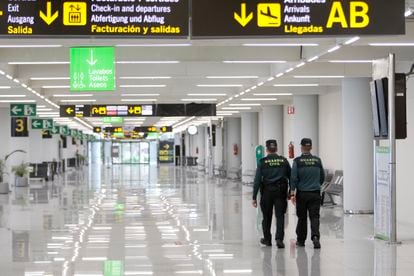Spanish regions open borders for family visits over Christmas
Valencia, however, will not allow travel for this reason, while others have requested documentation to justify the trip
/cloudfront-eu-central-1.images.arcpublishing.com/prisa/3XOY2V6VDJB7TPTSYEUAAIG2VY.jpg)

The Spanish Health Ministry’s travel rules for the Christmas holiday period came into force on Wednesday. Under this plan, which aims to reduce the spread of the coronavirus, regions in Spain must close their borders from December 23 until January 6. The main exception to this rule is for visits to see family or allegados, a term meaning people with whom there is a close bond, and which has sparked widespread confusion.
For the majority of regions that were already under a perimetral lockdown, the new rules represent an easing of restrictions, given that travel for reasons other than work and medical visits is now allowed. In others, such as Madrid, which did not seal its border, the changes mean stricter restrictions on mobility.

Some regional authorities have also decided to toughen the Health Ministry’s restrictions. In Valencia, travel in and out of the region to see family or allegados is not allowed – only residents and those with justified reasons, such as work, are allowed to enter and leave.
Other regions have requested that travelers present a document stating that the reason for their trip is to see family or allegados. This is the case for Madrid, Catalonia, Basque Country, Navarre, La Rioja and Aragón, which have provided downloadable forms from the respective links. In the Balearic Islands, visitors do not have to specifically show that they are seeing family or friends, but they must fill out a health form explaining the reason for their trip. From December 20, travelers to the archipelago from regions with a high incidence rate have been required to provide a negative coronavirus test.
In other regions, only visits to see family members – not allegados – are allowed over the Christmas period. This rule applies in Aragón, Castilla y León, Extremadura and Murcia. Meanwhile, in the Canary Islands, there are no restrictions on travel, except in Tenerife, which is under a perimetral lockdown due to a new surge in coronavirus cases. All visitors to the archipelago from Spain – except for children under the age of six – must provide a negative antigen test taken within 72 hours of their arrival. This rule will remain in place until January 10.
Coronavirus incidence continues to rise
The national incidence rate of the coronavirus continues to rise, according to the Health Ministry’s latest report, released Tuesday evening. This data point has been increasing at a consistent rate since December 9, when the upward trend began after five weeks of consecutive falls. According to Tuesday’s report, the 14-day cumulative number of cases per 100,000 inhabitants now stands at 234. The Health Ministry also reported 10,654 new coronavirus cases and added 260 deaths to the official toll.

The uptick in the incidence rate is still not having a significant impact on Spain’s hospitals, where the occupancy rate remains stable. There are currently 11,500 Covid-19 patients in hospital, equating to an occupancy rate of 9.4%. Of that figure, 1,906 are in intensive care units (ICUs), which translates to 20% of all ICU beds.
The Balearic Islands have seen the sharpest rise in the incidence rate, with the 14-day cumulative number of cases per 100,000 inhabitants now at 433. The next worst-affected regions are Madrid (329), Valencia (309) and Extremadura (305). The virus is spreading at different speeds across the country, as has been seen throughout the second wave: while some regions record peak transmission rates, others report drops in contagions, and vice versa. This is the case for Asturias, Cantabria and Murcia, which were once the hardest-hit regions in Spain, but now have among the best epidemiological situations in the country. The territory with the lowest incidence rate is the North African exclave city of Ceuta, where the 14-day cumulative number of cases per 100,000 cases is 110, followed by the Canary Islands (133) and Andalusia (139).
English version by Melissa Kitson.
/cloudfront-eu-central-1.images.arcpublishing.com/prisa/FXXFMKGDTWAZBAZGT3EAQLQT3U.jpg)
/cloudfront-eu-central-1.images.arcpublishing.com/prisa/MLLCJETXPQUH3IB32BBICSQ22U.jpg)










































